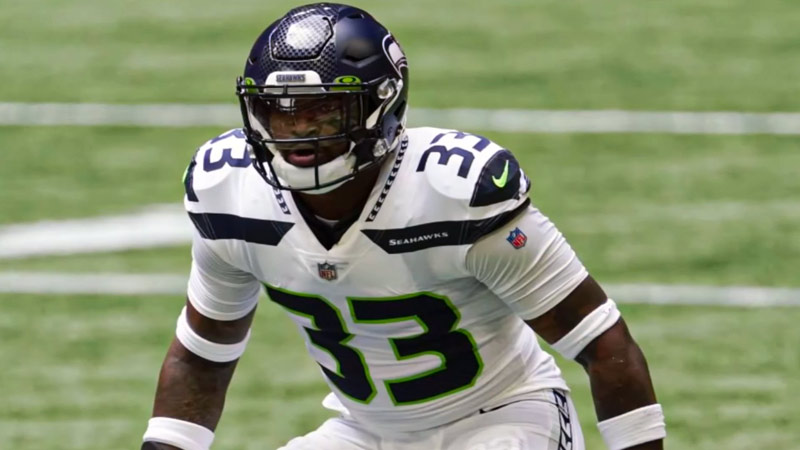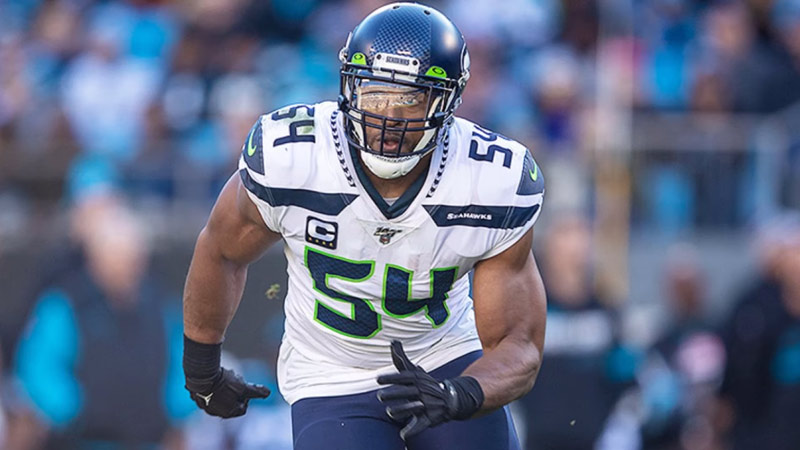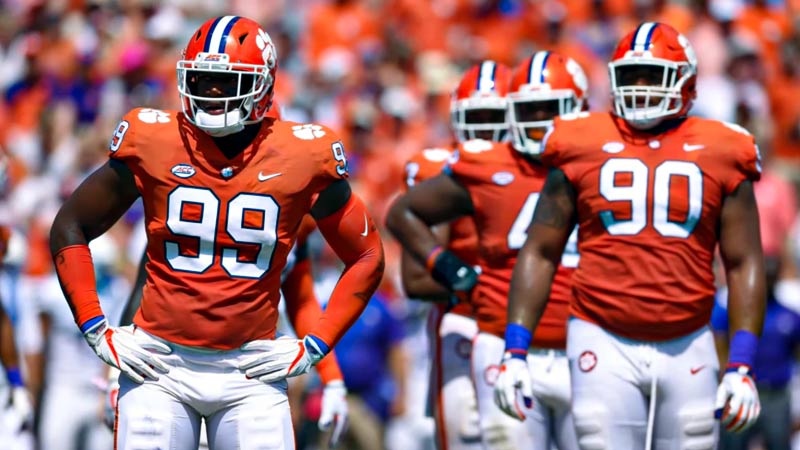American football is a dynamic and strategic sport that involves a complex defensive setup to thwart the opponent’s offensive efforts. In this guide, we delve into the various defensive positions that players assume on the gridiron.
These positions demand unique skills, from robust tackling to agile coverage, and they collectively form a cohesive defensive unit.
Whether you’re a football enthusiast or a newcomer to the sport, understanding these positions is pivotal in grasping the intricacies of the game.
What Are The Defensive Positions In Football?
Defensive positions in football comprise a strategic lineup to thwart opponents. These include 1 Nose Guard, 1 Defensive Tackle, 2 Defensive Ends, 2 Inside Linebackers, 2 Outside Linebackers, 2 Cornerbacks, and 1 Safety.
The Nose Guard and Defensive Tackle fortify the interior line, impeding runs and pressuring the quarterback. Defensive Ends maneuver to contain rushes and rush the passer.
Inside Linebackers monitor run plays and contribute to pass coverage. Outside Linebackers blend pass defense with edge containment.
Cornerbacks guard against receivers, aiming to deflect passes. Safeties provide last-ditch coverage and aid against deep throws. This defensive formation aims to nullify offensive advances and secure the field.
11 Defensive Football Positions in Football
Generally, there are in total 11 defensive football positions in football. Here are the short descriptions of these positions.
Nose Guard
The Nose Guard, positioned at the center of the defensive line, shoulders the task of disrupting the opposing team’s interior offensive line. This player is pivotal in both run defense and generating pressure on the quarterback.
Their primary duty revolves around plugging gaps and clogging running lanes, impeding running backs from gaining ground up the middle.
By engaging with offensive linemen, the Nose Guard can create chaos at the line of scrimmage, freeing up linebackers to make tackles.
Responsibility
- Run Defense: Plugging gaps in the offensive line to prevent running backs from advancing through the middle.
- Disrupting Plays: Penetrating the line of scrimmage to disrupt the quarterback’s timing and cause chaos in the backfield.
- Creating Pressure: Applying pressure on the quarterback, forcing hurried throws and potential turnovers.
- Drawing Double Teams: Attracting the attention of multiple offensive linemen, freeing up teammates to make plays.
Defensive Tackle
Found beside the Nose Guard, the Defensive Tackle also plays a vital role in run defense. They combine strength, agility, and awareness to penetrate the offensive line, disrupt plays, and halt running backs in their tracks.
In pass-rushing situations, they aim to collapse the pocket, pressuring the quarterback and disrupting passing lanes.
Versatility is key, as they must transition seamlessly between clogging running lanes and applying pressure on the passer.
Responsibility
- Disrupt the Offensive Line: The primary goal is to disrupt the offensive line’s blocking schemes, creating chaos in the backfield and disrupting running plays or pressuring the quarterback.
- Plug Running Lanes: These players aim to clog running lanes, forcing running backs to change direction or get stopped for minimal gains.
- Generate Interior Pressure: When facing passing plays, their task is to collapse the pocket from the inside, making it difficult for the quarterback to step up and throw.
Defensive Ends

Flanking the defensive line, Defensive Ends are multifaceted players responsible for containing runs to the outside and pressuring quarterbacks. During run plays, they set the edge by preventing ball carriers from turning upfield.
In pass-rushing situations, they use speed and technique to outmaneuver offensive tackles and create pressure on the quarterback. Their ability to switch between containment and aggressive attacks adds flexibility to the defense, forcing offenses into unfavorable decisions.
Additionally, their performance impacts the overall success of the defense by limiting running opportunities and creating potential turnovers.
Responsibility
- Edge Containment: Defensive ends aim to maintain the outer boundaries of the defensive formation, preventing running backs from reaching the sidelines and turning upfield.
- Pass Rush: They are responsible for applying pressure on the quarterback by using their speed, technique, and strength to get past offensive tackles and disrupt passing plays.
- Force Inside: In run defense, they work to force runs back toward the interior of the defense, where their teammates can make tackles.
Inside Linebackers
Inside linebackers are key figures in the defensive setup, positioned near the middle of the field. They hold pivotal responsibilities against both run and pass plays. Primarily, they read the offense’s intentions and react accordingly.
Against the run, they fill gaps to stop running backs, tackle ball carriers, and prevent substantial gains. They also need to diagnose plays quickly, shedding blockers to make impactful tackles.
In pass coverage, inside linebackers often guard against short-to-intermediate routes by tight ends, running backs, and slot receivers. Their ability to drop back into coverage and disrupt passing lanes is crucial.
Responsibility
- Run Stopping: Inside linebackers must diagnose run plays quickly, fill gaps, and make tackles to limit gains by ball carriers.
- Short-to-Intermediate Pass Coverage: They cover routes by tight ends, running backs, and slot receivers, aiming to break up passes or limit yards after the catch.
- Read and React: Their ability to read the offense’s intentions helps them make timely decisions on whether to pursue the ball or maintain their coverage responsibilities.
Outside Linebackers
The role of outside linebackers involves a blend of pass rush and coverage skills. Often situated on the edges, they aim to apply pressure on the quarterback by bypassing blockers and sacking or hurrying the passer.
Their quickness, agility, and technique are essential in this aspect. In run defense, outside linebackers must set the edge, preventing ball carriers from getting to the outside and forcing them back toward the interior of the defense.
In pass coverage, they may cover tight ends, running backs, and sometimes even wide receivers. Their athleticism enables them to drop into coverage zones and disrupt passing lanes, making interceptions or deflections.
Responsibility
- Coverage and Disruption: Cornerbacks aim to closely cover wide receivers, disrupting their routes and preventing them from making catches.
- Ball Skills: Intercepting passes or deflecting them to prevent completions is a crucial aspect of their role.
- Limit Yards: By preventing receivers from gaining significant yards after the catch, cornerbacks contribute to overall defensive success.
Cornerbacks
Cornerbacks are the first line of defense against wide receivers and passing plays. Their primary duty is to shadow and cover opposing receivers closely, aiming to prevent them from catching the ball.
Cornerbacks use their speed, agility, and technique to mirror the movements of receivers and contest passes.
They must anticipate routes and react swiftly to changes in direction. Additionally, cornerbacks need to be skilled at reading the quarterback’s intentions to position themselves optimally for interceptions or deflections.
Responsibility
- Edge Set and Containment: Similar to defensive ends, outside linebackers ensure that running plays are forced back inside and prevent ball carriers from getting to the outside.
- Pass Rush and Coverage: They need to rush the passer effectively while also being able to drop into coverage against various receiving targets.
- Versatility: Outside linebackers should be adept at both run defense and pass coverage, providing flexibility for the defensive scheme.
Safety
The safety position combines aspects of coverage and run support. Safeties are the last line of defense, responsible for preventing big plays and deep passes.
They play a vital role in covering deep zones and providing support to cornerbacks. Safeties need to recognize plays and communicate effectively with their teammates to ensure proper coverage.
In run defense, they act as an extra line of defense, coming up to make tackles on running backs who have broken through the front lines. Strong safeties are often more involved in run support, while free safeties excel in pass coverage.
Responsibility
- Deep Coverage: Safeties are responsible for preventing deep passes and big plays by covering large areas of the field.
- Reading the Quarterback: Their ability to read the quarterback’s intentions helps them anticipate passes and position themselves optimally for interceptions or pass breakups.
- Run Support: Safeties also provide support against running plays, helping to tackle ball carriers who break through the front lines.
These defensive football positions work cohesively to control the line of scrimmage, thwart runs, and disrupt passing plays. Their responsibilities are pivotal in establishing defensive dominance and setting the tone for the entire team.
Challenges of the Players in Defensive Football Positions

Players in defensive football positions face a range of challenges that require a combination of physical, mental, and strategic skills to overcome.
These challenges can vary based on the specific position within the defensive unit, but there are some common themes:
Tactical Awareness
Defensive players need to have a deep understanding of the team’s defensive strategies, formations, and positional responsibilities.
They must be able to read the game, anticipate the opponent’s moves, and adjust their positioning accordingly to prevent scoring opportunities.
One-on-One Battles
Defenders often find themselves in direct one-on-one battles with attacking players. This requires excellent man-marking skills, the ability to hold off attackers while maintaining balance, and the skill to dispossess opponents without committing fouls.
Physical Conditioning
Defensive players need to maintain high levels of physical fitness and endurance. They must be able to run, sprint, and change directions quickly throughout the match, as well as handle the physical challenges of jostling, tackling, and jumping.
Communication
Effective communication is crucial in defense to coordinate positioning, mark opponents, and provide support to teammates. Defenders need to be vocal leaders on the field, ensuring that everyone is on the same page and responding to changing situations.
Decision-Making
Split-second decision-making is vital in defensive positions. Defenders must decide whether to challenge an attacker, hold their ground, intercept passes, or make tackles.
Incorrect decisions can lead to scoring opportunities for the opposing team.
Maintaining Discipline
Defensive players often need to maintain discipline and avoid rash challenges or positional errors that could lead to penalties or free-kick opportunities for the opponent.
Staying patient and composed, especially when under pressure, is crucial.
Handling Speedy Attackers
Players in defensive positions often encounter fast and skillful attackers who can quickly change direction and accelerate.
Defenders need to be agile, maintain proper body positioning, and use their spatial awareness to keep up with these attackers.
Set Pieces and Dead Balls
Defenders need to excel in defending set pieces such as corners, free kicks, and throw-ins. They must anticipate runs, mark opponents tightly, and win aerial duels to prevent the opposing team from capitalizing on these opportunities.
Adapting to Different Styles
Different opponents employ various playing styles, so defenders must adapt to the strategies of each team they face.
This requires a versatile approach, where defenders can adjust their tactics and positioning based on the strengths and weaknesses of the opposing team.
Mental Resilience
Mistakes are inevitable in football, and defenders must have the mental resilience to bounce back from errors and remain focused throughout the match.
A strong mentality helps them maintain confidence and continue performing at their best.
Transition Defense
When the team loses possession, defenders need to quickly transition from attacking to defensive positions to prevent counterattacks.
This requires swift decision-making and rapid movement to close down spaces and regain defensive shape.
Pressure and Expectations
Players in defensive positions often face immense pressure and expectations from fans, coaches, and teammates. Any errors they make can be magnified, so maintaining self-belief and confidence is essential to perform under pressure.
Players in defensive football positions need a combination of technical, tactical, physical, and mental skills to succeed.
Their ability to work as a unit, communicate effectively, and adapt to different situations is crucial in helping their team maintain a solid defense and ultimately achieve success on the field.
FAQs
What are the primary defensive positions in American football?
The primary defensive positions include defensive linemen, linebackers, cornerbacks, and safeties. Each position has distinct responsibilities in defending against the offense’s plays.
What do defensive linemen do?
Defensive linemen, positioned on the line of scrimmage, aim to disrupt the opposing team’s offensive plays by pressuring the quarterback and stopping running plays.
What role do linebackers play in the defense?
Linebackers are versatile players who contribute to both run defense and pass coverage. They play just behind the defensive line and are responsible for reading plays and making tackles.
How do cornerbacks and safeties differ?
Cornerbacks cover wide receivers and prevent them from catching passes, while safeties provide deep coverage and support against both the pass and the run.
Are there specialized defensive formations?
Yes, teams use various formations to adapt to different offensive strategies. These formations determine how defenders line up and work together to counter the opponent’s tactics.
Wrapping Up
From the hard-hitting defensive linemen to the agile cornerbacks, the array of defensive positions in American football showcases the sport’s multifaceted nature.
Each position contributes uniquely to the overall defensive strategy, underscoring the importance of teamwork, versatility, and adaptability on the field.
As fans, appreciating the roles and responsibilities of these positions adds depth to our understanding of the thrilling game of American football. Thank you for your time.







